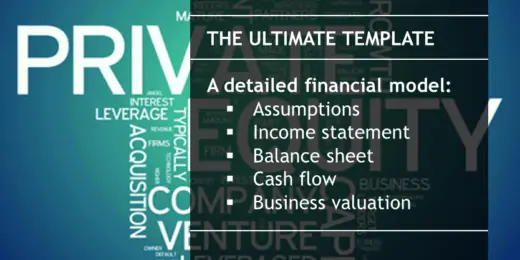The Valuation of a Business

Simply defined, a business valuation is a special type of financial analysis that results in estimation or opinion as to where the value of a business should lie within as per a given point in time. For another definition, see Investopedia. Valuation is subjective and therefore it depends from which perspective a valuation is performed. Many times, an estimation of a company’s value seeks to assume the point of view of a fair market perspective, resulting in the fair market value of a business.
When assessing the value of a privately held company, many times there is no independent market value available and even comparable data are unreliable because every business and circumstances are different. Therefore, an assessment of the worth of a company is needed using standard business valuation techniques.
The valuation of a business is an art rather than an exact science, and a properly conducted valuation analysis is an expression of an informed opinion based on certain assumptions and scenarios. By their very nature, the results of such analysis are not precise and neutral. Many times there is a lot of subjective professional judgment needed starting from the selection of the appropriate valuation methods, the selection of the scenario, assumptions, and even up to the interpretation of the results. Such company appraisals normally are performed by a professional financial modeler or valuation expert which can lead to a bias in the result of the appraised value.
Professional business valuation experts will seek to mitigate this critique with the following:
- They state the final result as a range of where a reasonable value of a company should lie within to count for a certain degree of imprecision.
- They use different valuation methods to count for different perspectives and better triangulate with other data points where a reasonable value of an asset or a business should lie within.
Therefore, valuation in business is no precise science and also can be quite subjective.
The Meaning of Value
To determine the value of a business, one first must define the meaning of value. It is often the most complicated and misunderstood. It is mostly subjective as to what is ‘value’ to one person which may be different from others.
Liquidation Value is an asset sold under a liquidation scenario such as bankruptcy or simply closing down of all commercial activities. This normally means that the values for receivables, inventory needs to be adjusted downwards as they will need to assume lower prices during the liquidation. However, many times there are also hidden reserves present, e.g. a building might be worth more when sold than the book value stated on the balance sheet. This will result in a higher realizable value but will also trigger a potential tax liability from that gain. Intangible assets such as a brand might not be sellable in a liquidation scenario, ergo their value might be zero. Asset-based lenders and banks frequently use the concept of liquidation value as they regularly will experience defaults on their loan portfolio and will seek to protect their downside risk
Intrinsic Value is a concept of value based on financial analysis opposed to using the stock market price of a company. It normally is based on fundamental analysis, many times using forecasted free cash flows via the DCF method. Understanding the intrinsic value can help to separate the market sentiments for prevailing prices paid on the stock market while focusing on the fundamental value of a company. It is the true economic worth of a share, corporation, or property.
Value of Control is the value that one can get when controlling a business e.g. owning a majority stake of a corporation (>50% of the share capital) as opposed to owning a minority stake (e.g. 1 share of a multinational public company from the stock market). The value of the control is that the owner can make all the decisions of relevance to the company and determine its destiny. In the value of skilled entrepreneurs, having control of a company is worth much more than having to be restricted by the assessment and decisions of others. In simpler terms, the value of the control is the value of shares in a company when the number of shares owned is sufficient enough to take control of the company.
Perceived Value is normally is subjective and depends on the observer, his/her assumptions, and the business scenario. It could be related or not to the ‘true market price’ and only depends on the ability of the business to satisfy the needs of the entity involved.
Fair market value involves a consideration of all relevant factors to determine value from a neutral perspective of any independent market participated. This scenario assumes an unbiased transaction between a willing buyer and seller, without any forceful demand to buy or sell. Basically, the buyer and seller are presumed to have knowledge of reasonable, relevant facts relating to the imagined transaction as of a specific valuation date. With respect to GAAP, fair value is often associated, and used interchangeably, with fair market value, and is employed by accountants as well as financial analysts in the preparation of standard valuation models used which can be used by anybody (e.g. research reports about a certain stock).
Common Company Valuation Methods
Common business valuation methods – among others – are the following ones:
- Net Asset Valuation
- Capitalized Earnings Valuation
- Discounted Free Cash Flow (DCF) Valuation CF
- Replacement Cost Analysis
- Economic Profit
- Venture Capital Valuation
- Recent Transaction Analysis
- Comparable Analysis of similar publicly quoted companies

For Financial Modeling purposes, the DCF Analysis is probably the most widely used analysis as it allows to obtain a very deep understanding of how value is generated and which main assumptions form the basis for a company’s valuation. For more information about common business valuation methods, please refer to our article about common business valuation approaches.
When is a Valuation in Business required?
The purpose of a valuation of a business is to determine what an asset or a corporation is worth so that shareholders or investors can use it for financial decision-making. This can be used also when investing in the stock market in the selection of stocks or in private equity.
Valuing a business is a critical function when acquiring a company since a buyer will want to ensure that he gets value for the price he pays. This can also include assessing the value of synergies when two companies are combined. The higher the value of synergies result, the more a buyer can afford to pay a higher price.
The need for conducting a business valuation exercise normally is triggered by an event at the shareholder level that leads to the question of what is the value of the company. Therefore, we can list common types of events that trigger this analysis:
Shareholder disputes
- Investment evaluation
- Acquisition of a Company
- Quantification of Synergies
- The intended Sale of a Company or an Asset
- Buy-back of Shares
- Buy-out of Shareholders
- Valuation for Tax Purposes
- Valuation for Court-Cases
- Raising Funding from new Investors
- Issuing Equity capital
- Goodwill Impairment Test
- Determining asset coverage ratios (e.g. Property Value / Financial Debt)
- Performance Measurement through Value-Based Management (e.g. Economic Proift
All these examples above will either require the preparation of a business valuation report.
Business Valuation Templates
To assist in the process, we have listed many industry-specific business valuation templates. They normally use the Net Present Value (NPV) or DCF Analysis to prepare an in-depth financial plan from which the NPV or DCF valuation can be calculated
These ready-made business valuation templates were prepared by skilled financial modeling experts who possess a wide range of financial modeling and valuation know-how. The spreadsheet templates are already downloaded many times and are used by users from different countries such as in the USA, UK, Germany, Australia, China, India, France, Switzerland, and many more who are in need of assistance with their financial modeling tasks.



















































